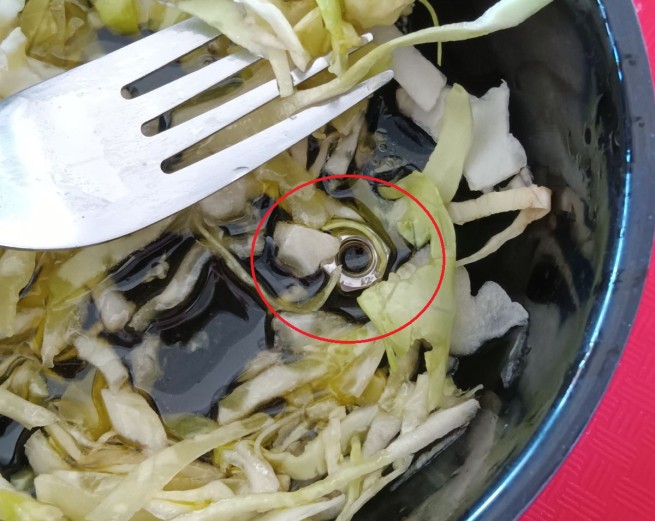Useful advice on the choice of food consumed during Lent is given by the Unified Food Control Agency (EFET) in the context of informing and protecting consumers from unscrupulous suppliers, and also reports on increased control in the food market during this period.
During Lent and especially on the three days of Holy Monday, in accordance with our eating habits, we move on to stocking and consuming certain lenten foods.
In addition to fruits, vegetables, cereals and legumes, foods consumed during fasting are fish, seafood and small fish caviar (taramas). Selecting them correctly, making sure to check the expiration date on the packaging, taking them home (before they are thawed), and handling them appropriately at home (cleanliness, maintaining the right temperature, thorough cooking) are important practices to avoid adverse health effects.
In the context of consumer information, EFET has issued a circular on what to look out for when buying seafood for the traditional Clean Monday dinner table.
The information applies to the entire range of seafood that are on the shelves of our country’s stores (both fresh and frozen).
EFET strongly recommends that you be extremely careful when purchasing seafood.
If you are looking to purchase fresh cephalopods (octopus, squid, cuttlefish, etc.), please note the following:
Smell: they should smell like the sea and not have an unpleasant smell of ammonia or any other (including chlorine). The surface of the carcass should be moist and glossy. The tentacles and suckers must be able to withstand light pull and not separate from the carcass. The flesh should be firm, elastic and glossy. The eyes should be shiny, “alive”, without spots and turbidity.
For frozen (packaged or bulk) foods, they are:
Should not have a strange hue (blue, green, purple – different from the normal white-pink). Usually have an ice layer (not melted). After defrosting, they should acquire the color and smell of a fresh product. The identification mark of the manufacturer and the expiration date must be indicated on the packaging.
For chilled fresh fish (on ice), you need to know that it comes exclusively from licensed production facilities. It is forbidden to defrost frozen fish and sell it at retail (and by no means pass it off as fresh!).
When sold, frozen or chilled fish must have a certificate regarding the condition of the product (clear indication – chilled or frozen). Identification: the presence of a label with a trademark or a stamp on the package.
About shellfish (mussels, oysters, scallops, etc.), due to the fact that they are usually sold with closed doors, you need to know:
When choosing shellfish such as mussels and oysters (bivalves), pay attention to the integrity of the shells. If the flaps are open or slightly open (there is a gap), this is a sign that the product is most likely unsuitable for human consumption. When shaking, you should not feel anything dangling. The insides should be moist, clean and odorless. This is an extremely important indicator of the freshness of the mollusk – the absence of a specific smell. Professionals say that good mussels should only smell like the sea. If you bought frozen ones, before cooking, take them out of the freezer, let them thaw at room temperature, and then smell them. If you feel even a slight smell, it is better to refuse the delicacy. Flesh: Should be moist and firmly attached to the shell. As for peeled mussels sold on ice, their flesh should be glossy, firm and smell of the sea. Frozen clams should have an expiration date on the package. Do not buy sticky / frozen mussels, perhaps the product has been subjected to repeated freezing and thawing, which is strictly prohibited.
Shellfish (shrimp, lobster, crabs, etc.). These seafood are available fresh, frozen or chilled (on ice).
Fresh seafood:
Pleasant smell of the sea. The pincers are firmly and tightly attached to the body. The thoracic membrane is stretched, strong and transparent. The head and chest are light (no black or dark spots). Reflex movements of the eyes, antennae and legs, if the seafood is fresh (live).
In addition, you need to know that fresh shrimp slip out of your hands and do not have a sharp unpleasant odor.
Other gourmet food:
Taramosalata (appetizer of small fish caviar) should have a uniform color and soft texture, not have a bitter or sour taste. Pickled cucumbers should not be consumed by people with hypersensitivity of the stomach. The product “halva” needs special attention if you are allergic. Carefully study the inscription on the package to avoid eating halva, which may contain allergenic ingredients (including nuts). Also keep an eye on the amount of salt you eat, which can be found in excess in foods eaten during Lent (especially if you have high blood pressure!). Replace salt with spices. Sea urchins are also sold in the market, and you can determine that they are alive by the movement of their spines. When choosing canned products stored in or out of the refrigerator, consumers should be careful not to purchase a bloated can. In addition, it should not have rust, smudges. Pay attention to the expiration date of the product.
The information applies to the entire range of seafood that are on the shelves of our country’s stores (both fresh and frozen).
EFET strongly recommends that you be extremely careful when purchasing seafood.
If you are looking to purchase fresh cephalopods (octopus, squid, cuttlefish, etc.), please note the following:
Smell: they should smell like the sea and not have an unpleasant smell of ammonia or any other (including chlorine). The surface of the carcass should be moist and glossy. The tentacles and suckers must be able to withstand light pull and not separate from the carcass. The flesh should be firm, elastic and glossy. The eyes should be shiny, “alive”, without spots and turbidity.
For frozen (packaged or bulk) foods, they are:
Should not have a strange hue (blue, green, purple – different from the normal white-pink). Usually have an ice layer (not melted). After defrosting, they should acquire the color and smell of a fresh product. The identification mark of the manufacturer and the expiration date must be indicated on the packaging.
For chilled fresh fish (on ice), you need to know that it comes exclusively from licensed production facilities. It is forbidden to defrost frozen fish and sell it at retail (and by no means pass it off as fresh!).
When sold, frozen or chilled fish must have a certificate regarding the condition of the product (clear indication – chilled or frozen). Identification: the presence of a label with a trademark or a stamp on the package.
About shellfish (mussels, oysters, scallops, etc.), due to the fact that they are usually sold with closed doors, you need to know:
When choosing shellfish such as mussels and oysters (bivalves), pay attention to the integrity of the shells. If the flaps are open or slightly open (there is a gap), this is a sign that the product is most likely unsuitable for human consumption. When shaking, you should not feel anything dangling. The insides should be moist, clean and odorless. This is an extremely important indicator of the freshness of the mollusk – the absence of a specific smell. Professionals say that good mussels should only smell like the sea. If you bought frozen ones, before cooking, take them out of the freezer, let them thaw at room temperature, and then smell them. If you feel even a slight smell, it is better to refuse the delicacy. Flesh: Should be moist and firmly attached to the shell. As for peeled mussels sold on ice, their flesh should be glossy, firm and smell of the sea. Frozen clams should have an expiration date on the package. Do not buy sticky / frozen mussels, perhaps the product has been subjected to repeated freezing and thawing, which is strictly prohibited.
Shellfish (shrimp, lobster, crabs, etc.). These seafood are available fresh, frozen or chilled (on ice).
Fresh seafood:
Pleasant smell of the sea. The pincers are firmly and tightly attached to the body. The thoracic membrane is stretched, strong and transparent. The head and chest are light (no black or dark spots). Reflex movements of the eyes, antennae and legs, if the seafood is fresh (live).
In addition, you need to know that fresh shrimp slip out of your hands and do not have a sharp unpleasant odor.
Other gourmet food:
Taramosalata (appetizer of small fish caviar) should have a uniform color and soft texture, not have a bitter or sour taste. Pickled cucumbers should not be consumed by people with hypersensitivity of the stomach. The product “halva” needs special attention if you are allergic. Carefully study the inscription on the package to avoid eating halva, which may contain allergenic ingredients (including nuts). Also keep an eye on the amount of salt you eat, which can be found in excess in foods eaten during Lent (especially if you have high blood pressure!). Replace salt with spices. Sea urchins are also sold in the market, and you can determine that they are alive by the movement of their spines. When choosing canned products stored in or out of the refrigerator, consumers should be careful not to purchase a bloated can. In addition, it should not have rust, smudges. Pay attention to the expiration date of the product.






More Stories
Flood victims in Thessaly will pay property tax (ENFIA)
Fines of 1.5 million euros for 11 large retail chains, including Leroy Merlin, Attica and JYSK
Reuters reveals what the Mitsotakis government doesn't want to talk about: “Huge debt – low wages”